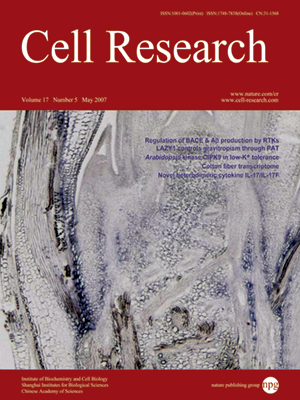Volume 17 Issue 5, May 2007: 458-470
ORIGINAL ARTICLES
The Arabidopsis Spontaneous Cell Death1 gene, encoding a ζ-carotene desaturase essential for carotenoid biosynthesis, is involved in chloroplast development, photoprotection and retrograde signalling
Haili Dong1,2, Yan Deng1,2, Jinye Mu1, Qingtao Lu3, Yiqin Wang1, Yunyuan Xu3, Chengcai Chu1, Kang Chong3, Congming Lu3 and Jianru Zuo1
1State Key Laboratory of Plant Genomics and National Plant Gene Research Center (Beijing), Institute of Genetics and Developmental Biology, Chinese Academy of Sciences, Beijing 100101, China
2Graduate School, Chinese Academy of Sciences, Beijing 100039, China
3Institute of Botany, Chinese Academy of Sciences, Beijing 100093, China
Correspondence: Jianru Zuo(jrzuo@genetics.ac.cn)
Carotenoids, a class of natural pigments found in all photosynthetic organisms, are involved in a variety of physiological processes, including coloration, photoprotection, biosynthesis of abscisic acid (ABA) and chloroplast biogenesis. Although carotenoid biosynthesis has been well studied biochemically, the genetic basis of the pathway is not well understood. Here, we report the characterization of two allelic
Arabidopsis mutants,
spontaneous cell death1-1 (
spc1-1) and
spc1-2. The weak allele
spc1-1 mutant showed characteristics of bleached leaves, accumulation of superoxide and mosaic cell death. The strong mutant allele
spc1-2 caused a complete arrest of plant growth and development shortly after germination, leading to a seedling-lethal phenotype. Genetic and molecular analyses indicated that
SPC1 encodes a putative ζ-carotene desaturase (ZDS) in the carotenoid biosynthesis pathway. Analysis of carotenoids revealed that several major carotenoid compounds downstream of SPC1/ZDS were substantially reduced in
spc1-1, suggesting that SPC1 is a functional ZDS. Consistent with the downregulated expression of
CAO and
PORB, the chlorophyll content was decreased in
spc1-1 plants. In addition, expression of
Lhcb1.1,
Lhcb1.4 and
RbcS was absent in
spc1-2, suggesting the possible involvement of carotenoids in the plastid-to-nucleus retrograde signaling. The
spc1-1 mutant also displays an ABA-deficient phenotype that can be partially rescued by the externally supplied phytohormone. These results suggest that
SPC1/ZDS is essential for biosynthesis of carotenoids and plays a crucial role in plant growth and development.
Cell Research (2007) 17:458-470 doi: 10.1038/cr.2007.37; published online 30 April 2007
FULL TEXT | PDF
Browse 2297


